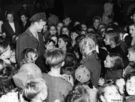(Bloomberg) — Gail Halvorsen, the U.S. military pilot who brought joy to Berlin’s children by dropping candy in tiny handkerchief parachutes from his plane when the Soviet Union blockaded the divided city during the Cold War, has died. He was 101.
He died Wednesday evening at Utah Valley Hospital in Provo, Utah, after a long illness, surrounded by most of his children, according to a Facebook post by his educational foundation.
Halvorsen was a pilot in the U.S. Army Air Corps — forerunner to the Air Force — during the Second World War, ferrying transport planes in England, Italy, and North Africa. He remained in the military after the war ended in 1945 and was stationed at Brookley Air Force Base in Mobile, Alabama, flying C-74 Globemaster and C-54 Skymaster transports stateside.
In 1948, the newly rechristened U.S. Air Force had a renewed need for pilots in Germany, where the Soviet Union under Joseph Stalin had implemented a blockade of West Berlin. The German capital, divided into zones occupied by the U.S., the U.K., France and the Soviet Union, was sealed off when Stalin blocked ground transportation into the Allied sectors of the city.
Flying the C-54 Skymaster, Halvorsen participated in the joint U.S.-U.K. effort known as the Berlin Airlift, which for almost a year delivered food and fuel to Berlin airfields from Allied bases in western Germany.
‘Like a Moonscape’
On Halvorsen’s first flight into Berlin’s Tempelhof Air Base, he delivered 20,000 pounds of flour while taking careful note of the war-torn city. “It looked like a moonscape,” he recalled in an interview with Military History magazine. “I wondered how 2 million people could live in a place so totally devastated.”
It was an additional, self-assigned mission that made Halvorsen famous.
On an off day, he hitched a ride on a transport flight to Berlin so he could shoot some footage with his movie camera. After landing at Tempelhof, he walked over to a group of about 30 German children who were watching all the activity through a fence.
“They came right up to the barbed wire and spoke to me in English,” he recalled. “Those kids were giving me a lecture, telling me, ‘Don’t give up on us. If we lose our freedom, we’ll never get it back.’ American-style freedom was their dream.”
Sticks of Gum
Their words left a mark on Halvorsen, as did the way they meticulously divided and shared two sticks of gum he gave them. He vowed to return with enough for all, to be delivered from the air. They’d know the plane was his because he’d wiggle the wings.
“My copilot and engineer gave me their candy rations — big double handfuls of Hershey, Mounds and Baby Ruth bars and Wrigley’s gum,” he recalled in the interview. “Three weeks we did it, three parachutes each time. The crowd got big.”
Soon, thank-you letters began to arrive in the barracks, addressed to “Uncle Wiggly Wings.” He feared the worst when photos of his plane made front-page news in local newspapers, which led to him being called in to explain his actions to his army superiors.
Instead of being penalized, he was ordered to drop even more sweet treats as his commanders realized the goodwill that Halvorsen was generating in East and West Berlin and at home in the U.S., where donations of candies and handkerchiefs were organized.
‘Candy Bomber’
Operation Little Vittles, as the drop of gum and chocolate bars came to be known, turned into a diplomatic coup, altering Germans’ perceptions of Americans and paving the way for future humanitarian airlifts. Halvorsen became known as the “Candy Bomber” and “Der Schokoladen Flieger” — “the Chocolate Flyer.”
In 1974, Halvorsen was awarded the Grand Cross of the Order of Merit of the Federal Republic of Germany for his kind deeds.
Gail Seymour Halvorsen was born on Oct. 10, 1920, in Salt Lake City. He grew up on farms in Utah and Idaho.
He was awarded a private pilot’s license as part of a civilian training program in 1941 before joining the U.S. Army Air Corps the following year. Halvorsen trained as a fighter pilot before transferring to air-transport assignments in the South Atlantic during the war.
Space Programs
Returning to the U.S. after the Berlin Airlift, he earned bachelor’s and master’s degrees in aeronautical engineering from the University of Florida.
His later work included assignments at the Air Force Space Systems Division in Inglewood, California, where he worked on the Titan III launch vehicle, and at Vandenberg Air Force Base in California, where he commanded satellite launch operations.
He also returned to Germany, and to Tempelhof, as commander of the 7350th Air Base Group, before retiring in 1974. He was an assistant dean at Brigham Young University from 1978 to 1988.
Halvorsen married his first wife, the former Alta Jolley of Utah, in 1949. She died in 1999. They had five children. He later married his childhood sweetheart, Lorraine Pace.
More stories like this are available on bloomberg.com
©2022 Bloomberg L.P.











